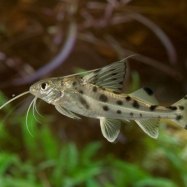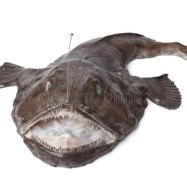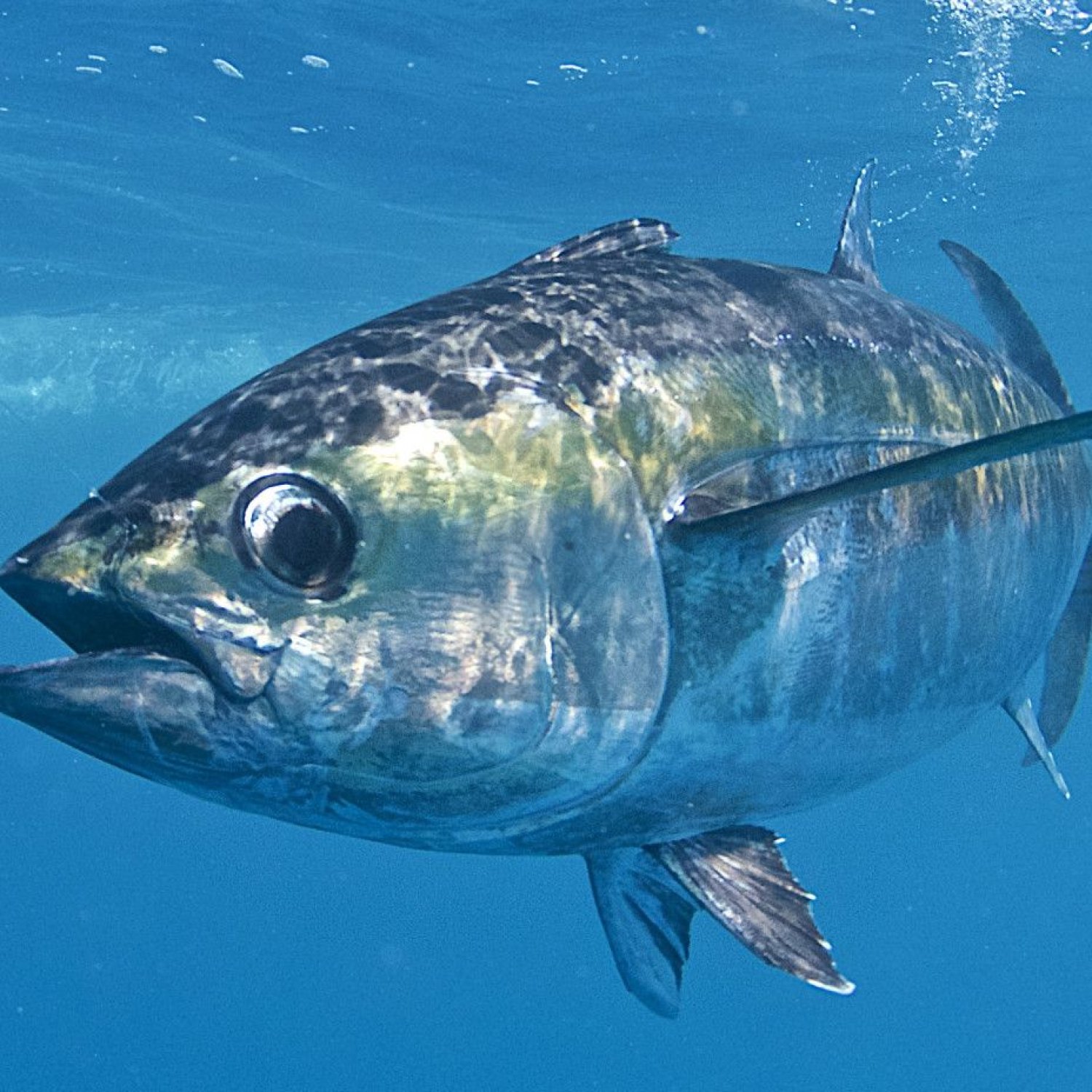
Blackfin Tuna
Up to 1.5 meters
The Blackfin Tuna, part of the Scombridae family, can grow up to 1.5 meters in length. It has a streamlined and elongated body, making it a fast and agile swimmer. Found in tropical and subtropical waters, this fish is a popular catch among fishermen and also an important part of the marine ecosystem. #BlackfinTuna #Scombridae #marinebiodiversity
Animal Details Summary:
Common Name: Blackfin Tuna
Kingdom: Animalia
Habitat: Open ocean
The Mighty and Mysterious Blackfin Tuna
Have you ever heard of the Blackfin Tuna? This elusive and impressive creature may not be as well-known as its larger relative, the Bluefin Tuna, but it certainly deserves recognition. With its dark blue or black back and silver-streaked belly, the Blackfin Tuna is a master of disguise in the open ocean. In this article, we will delve into the fascinating world of the Blackfin Tuna, from its scientific classification to its unique characteristics and behavior.The Blackfin Tuna, scientifically known as Thunnus atlanticus, is a species of fish found in the Atlantic Ocean, Gulf of Mexico, and Caribbean Sea Blackfin Tuna. Its common name, Blackfin Tuna, refers to its distinguishing feature of having dark-colored fins. This stunning fish belongs to the kingdom Animalia and is classified under the phylum Chordata and class Actinopterygii. It is part of the order Perciformes and the family Scombridae, which also includes species like Mackerel and Bonito.
The Blackfin Tuna's natural habitat is in the open ocean, where it can freely roam and hunt for its prey. Unlike many other fish species, the Blackfin Tuna is not restricted to a specific geographical location. Instead, it can be found in the tropical and subtropical waters of the Atlantic Ocean, Gulf of Mexico, and Caribbean Sea. Despite being found in these areas, the country of origin of the Blackfin Tuna remains unknown.
Like most tuna species, the Blackfin Tuna is a carnivorous predator, feeding primarily on fish, crustaceans, and cephalopods. Its streamlined and elongated body, coupled with its impressive swimming speed, makes it an efficient hunter in the open ocean Box Jellyfish. The Blackfin Tuna's diet consists of a variety of prey, including anchovies, herring, and squid, that can be found in the areas it inhabits.
One of the most striking features of the Blackfin Tuna is its coloration. As mentioned earlier, it has a dark blue or black back and a white or silver belly, earning it the nickname "the bluefin of the south." This coloration is an adaptation for camouflage, as it helps the Blackfin Tuna blend in with its surroundings and avoid detection from predators. It also has a distinct lateral line, a line of sensory organs running along the length of its body, which helps it detect movement in the water.
The Blackfin Tuna has a streamlined and elongated body, with a pointed head and a forked tail. This shape allows it to move swiftly through the water, reaching speeds of up to 45 miles per hour. Its powerful pectoral and dorsal fins also aid in its movement, allowing it to maneuver quickly and make sudden turns to catch its prey.
On average, the Blackfin Tuna can grow up to 1.5 meters in length, with the largest recorded specimen being 84 pounds. Despite its impressive size, it is still considered a smaller tuna species compared to its relatives like the Bluefin Tuna, which can grow up to 10 feet in length. However, the Blackfin Tuna makes up for its size with its agility and speed, making it a formidable predator in its habitat.
As part of the Scombridae family, the Blackfin Tuna is a highly sought-after game fish. It is a popular target for recreational fishermen due to its size, speed, and the challenge it presents when caught. Commercially, it is also an important catch, with a significant market in countries like the United States and Japan.
In recent years, the Blackfin Tuna has faced challenges in its natural habitat due to overfishing and pollution. As a result, its population has declined, leading to concerns about its conservation status. To ensure the sustainability of this species, it is crucial to manage fishing practices and reduce pollution in its habitat.
In conclusion, the Blackfin Tuna may not be as famous as its larger relatives, but it is a fascinating creature with unique characteristics and abilities. From its striking coloration as an adaptation for camouflage to its impressive speed and agility, the Blackfin Tuna is truly a marvel of nature. Let us continue to appreciate and protect this magnificent fish, and may it continue to thrive in the open ocean for generations to come.

Blackfin Tuna
Animal Details Blackfin Tuna - Scientific Name: Thunnus atlanticus
- Category: Animals B
- Scientific Name: Thunnus atlanticus
- Common Name: Blackfin Tuna
- Kingdom: Animalia
- Phylum: Chordata
- Class: Actinopterygii
- Order: Perciformes
- Family: Scombridae
- Habitat: Open ocean
- Feeding Method: Carnivorous
- Geographical Distribution: Atlantic Ocean, Gulf of Mexico, Caribbean Sea
- Country of Origin: Unknown
- Location: Tropical and subtropical waters
- Animal Coloration: Dark blue or black on the back, white or silver on the belly
- Body Shape: Streamlined and elongated
- Length: Up to 1.5 meters
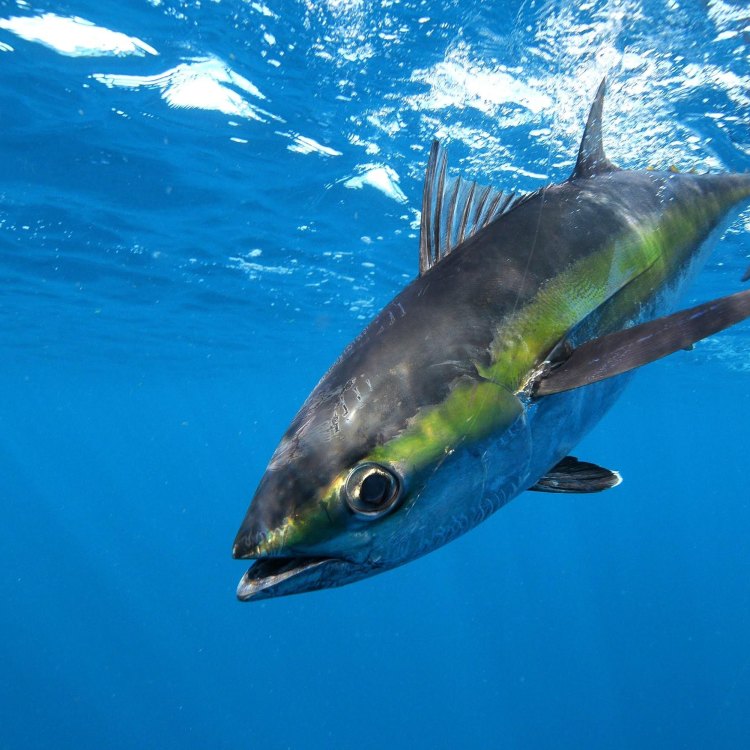
Blackfin Tuna
- Adult Size: Up to 15 kilograms
- Average Lifespan: 5 to 12 years
- Reproduction: Sexual
- Reproductive Behavior: Spawning
- Sound or Call: Unknown
- Migration Pattern: Migratory
- Social Groups: Solitary or in schools
- Behavior: Fast and agile swimmers
- Threats: Overfishing, habitat destruction
- Conservation Status: Near Threatened
- Impact on Ecosystem: Important role as a predator in the marine food chain
- Human Use: Commercial and recreational fishing
- Distinctive Features: Black finlets and yellow finlets
- Interesting Facts: Blackfin Tuna are highly prized for their meat and are often used in sushi and sashimi
- Predator: Sharks, larger predatory fish
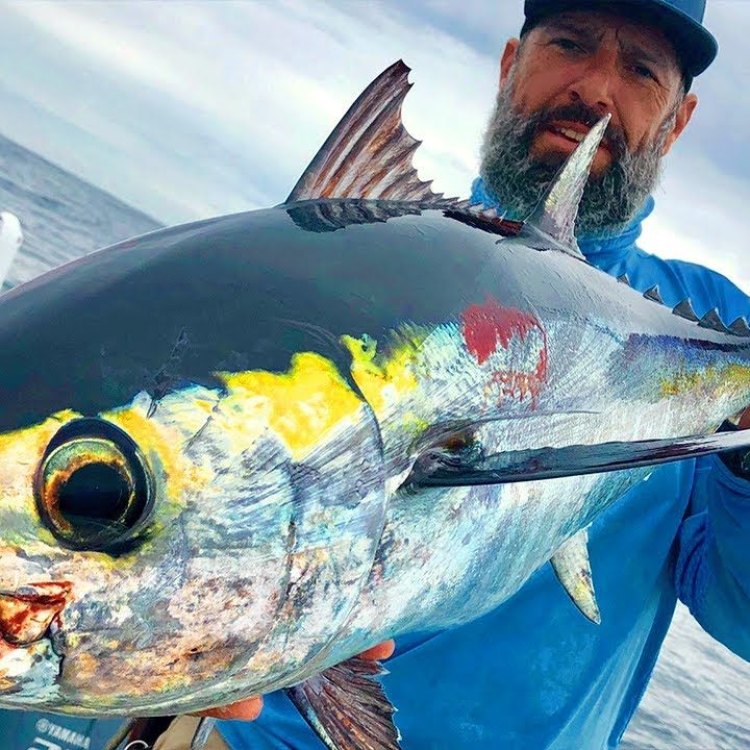
Thunnus atlanticus
The Magnificent Blackfin Tuna: A Predatory Powerhouse of the Ocean
The world's oceans are teeming with a diverse array of creatures, from tiny plankton to massive whales. But there is one species that stands out among the rest with its sleek and powerful presence - the Blackfin Tuna (Thunnus atlanticus).Known for their impressive size and incredible speed, Blackfin Tuna are highly valued by commercial and recreational fishermen alike. But there is so much more to this incredible species than just being a popular catch PeaceOfAnimals.Com. Let's dive deeper into the world of the Blackfin Tuna and discover what makes them so unique and important in the marine ecosystem.
The Physical Characteristics of the Blackfin Tuna
Adult Blackfin Tuna can reach weights of up to 15 kilograms (33 pounds) and can grow to be more than three feet long. They have a relatively short lifespan, ranging from 5 to 12 years, which may be influenced by factors such as predation and environmental conditions.One of the most distinctive features of the Blackfin Tuna is, as the name suggests, their black finlets and yellow finlets. These finlets, or small fins, are located along the back and near the tail of the fish. They help to stabilize the tuna and give them the agility needed to navigate through the water at high speeds.
Their bodies are also designed for speed, with a streamlined shape and smooth scales that reduce drag as they cut through the water. This, coupled with their muscular bodies and strong fins, makes the Blackfin Tuna one of the fastest and most agile swimmers in the ocean.
Reproductive Behavior and Social Groups
Blackfin Tuna are sexual reproducers, meaning that they require a male and female to reproduce Bulldog Mix. They engage in spawning, where female tuna release eggs into the water and males release sperm to fertilize them. This typically occurs in warmer waters during the spring and summer months, with females producing large numbers of eggs in a single spawn.After spawning, Blackfin Tuna may migrate to different locations depending on the availability of food and favorable water temperatures. They are considered to be migratory, with some populations traveling long distances between their spawning and feeding grounds.
In terms of social groups, Blackfin Tuna are typically solitary hunters, but they can also be found in schools. These schools can range from a few individuals to hundreds, and they may form for protection, hunting, or as a response to environmental factors. Within these schools, the tuna will exhibit synchronized movements and behaviors, acting almost as a single unit.
The Blackfin Tuna's Importance in the Ecosystem
As top predators, Blackfin Tuna play an essential role in maintaining the balance of the marine ecosystem. They feed on smaller fish, such as sardines, mackerel, and anchovies, which helps to control their populations. This, in turn, prevents the depletion of important plant and animal populations and helps to maintain the health of the ocean.However, the Blackfin Tuna is also prey to larger predatory fish and sharks, highlighting the interconnectedness of the marine food chain. Without the presence of Blackfin Tuna, there could be potential cascading effects on the marine ecosystem, affecting the populations of both predators and prey.
Threats to Blackfin Tuna and Conservation Efforts
Despite their strong predatory nature, Blackfin Tuna face significant threats that have impacted their populations in recent years. Overfishing, particularly in the Gulf of Mexico, has led to a decline in their numbers. This is due to the demand for their meat, which is considered a delicacy and is often used in sushi and sashimi.In addition to overfishing, Blackfin Tuna also face threats from habitat destruction, pollution, and climate change. These factors can disrupt their reproductive behaviors, migration patterns, and access to food, which can have serious consequences for their populations.
In response to these threats, various conservation efforts are in place to protect the Blackfin Tuna. The International Union for Conservation of Nature (IUCN) has classified them as "Near Threatened," and they are listed on the IUCN Red List. This means that the species is at risk of becoming threatened in the future, and further conservation efforts are needed to prevent this from happening.
Some measures being taken to conserve Blackfin Tuna include implementing fishing quotas, promoting sustainable fishing practices, and creating protected areas where they can thrive without human interference. It is crucial for these efforts to continue to ensure the survival of this magnificent species for future generations.
The Unique Predators of the Ocean
Blackfin Tuna are not the only creatures of the ocean that possess impressive predatory abilities. Other species, such as sharks and larger predatory fish like marlin, also play a critical role in maintaining the balance of the marine ecosystem. These predators have evolved unique hunting strategies and physical adaptations that make them formidable hunters and apex predators.For example, sharks have a set of specialized senses that help them to detect prey from long distances, including electroreception, which allows them to sense tiny electrical fields given off by other animals. Some sharks also have powerful jaws and teeth that can easily tear through flesh, making them formidable hunters.
Marlin, on the other hand, have long, sword-like bills that they use to stun and impale their prey. This allows them to hunt larger fish and also defend themselves against potential predators. These distinctive features, along with their agility and speed, make marlin and other oversized predatory fish apex predators in the ocean.
In Conclusion
The Blackfin Tuna is a remarkable species that possesses a combination of speed, agility, and predatory abilities that make them a force to be reckoned with in the ocean. While they face threats from overfishing and habitat destruction, they also play an essential role in maintaining the health of the marine ecosystem.Through conservation efforts and sustainable fishing practices, we can ensure the survival of this magnificent species for generations to come. So, the next time you enjoy a piece of tuna, take a moment to appreciate the incredible journey this fish has taken - from the ocean depths to your plate.
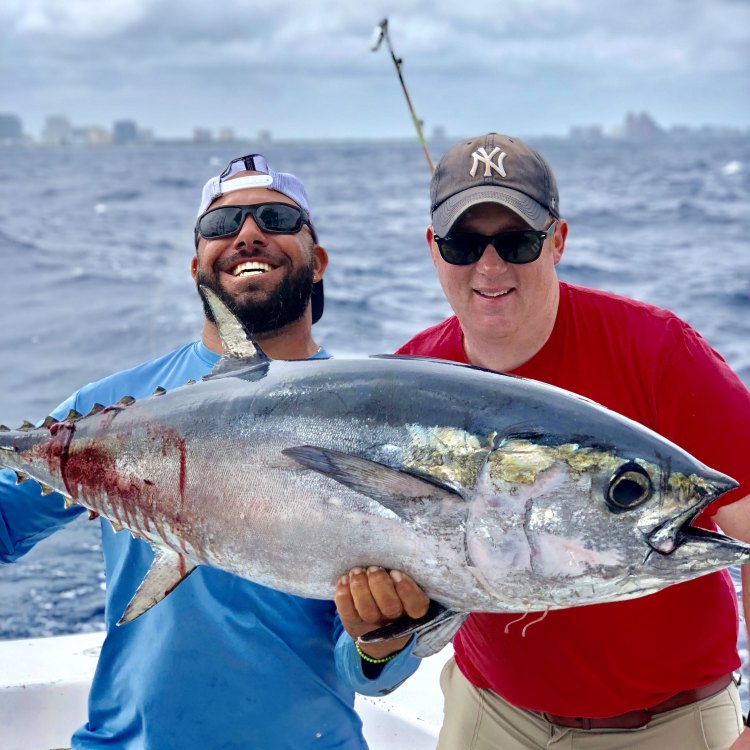
The Mighty and Mysterious Blackfin Tuna
Disclaimer: The content provided is for informational purposes only. We cannot guarantee the accuracy of the information on this page 100%. All information provided here may change without prior notice.



